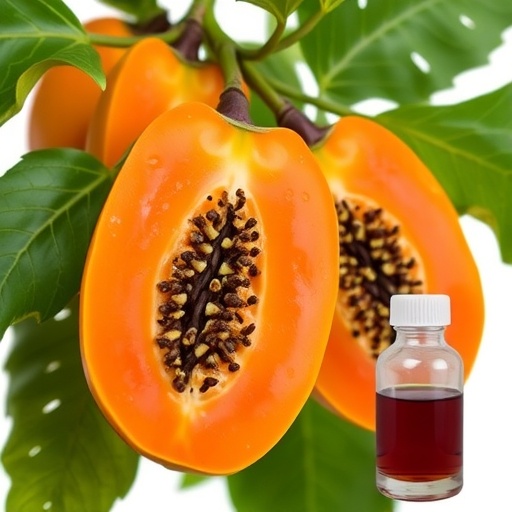In a groundbreaking advance in parasitology and natural product research, scientists have discovered that aqueous extracts derived from the embryogenic callus of Carica papaya demonstrate potent anti-amoebic activity against Entamoeba histolytica trophozoites. This research not only highlights the surprising efficacy of plant tissue culture derivatives in direct protozoan parasite killing but also unveils their unexpected potential in preventing the progression of amoebic liver abscesses in vivo. The implications of these findings could revolutionize approaches to combating amoebiasis, particularly in regions where the disease remains a significant public health burden.
Entamoeba histolytica, the causative agent of amoebiasis, is a protozoan parasite known for its invasive trophozoite stage, which can lead to severe tissue damage and abscess formation, most notably in the liver. Despite the availability of current pharmaceutical interventions, challenges such as drug resistance, side effects, and limited accessibility in endemic regions necessitate the exploration of alternative therapeutics. The study under discussion focuses on harnessing the natural bioactive compounds present in Carica papaya, a tropical fruit plant long recognized in ethnomedicine for its medicinal properties.
The unique aspect of this investigation lies in the use of embryogenic callus cultures—undifferentiated plant cells cultivated under sterile laboratory conditions—as the source material for extraction. Embryogenic callus is known to produce secondary metabolites at concentrations and profiles distinct from those found in mature plants, which can potentially unlock novel or enhanced bioactivities. By preparing aqueous extracts from these calli, the researchers ensured the retention of water-soluble phytochemicals that may play a critical role in targeting E. histolytica.
In vitro assays demonstrated that these extracts exerted a lethal effect on E. histolytica trophozoites, the motile and pathogenic stage responsible for host tissue invasion. The mechanistic basis for this anti-parasitic activity was probed, revealing interference with trophozoite viability and morphology. While the precise molecular targets remain to be fully elucidated, preliminary data suggest that the extracts disrupt membrane integrity and induce oxidative stress within the parasite, contributing to rapid cell death.
Beyond in vitro efficacy, the in vivo relevance of the extracts was tested using hamster models that mimic human amoebic liver abscess formation. Remarkably, oral administration of these aqueous extracts significantly reduced the development and severity of abscesses compared to untreated controls. This finding underscores the potential of these plant-derived compounds not only to directly target trophozoites but also to modulate host-pathogen interactions in a way that limits disease progression.
This dual mechanism of action—direct amoebicidal effects coupled with protective oral administration—positions the Carica papaya callus extracts as promising candidates for adjunct or alternative therapies against amoebiasis. The safety profile, ease of preparation, and oral bioavailability further enhance their appeal, especially for resource-limited settings where synthetic drugs face logistical and economic hurdles.
Interestingly, this study builds upon a growing body of evidence that plant tissue culture techniques can serve as renewable and controllable sources of potent natural products. By leveraging biotechnological platforms, researchers can optimize conditions to maximize the yield of pharmacologically active compounds, potentially overcoming variability associated with traditional plant harvesting and extraction.
The discovery also invites further exploration into the spectrum of phytochemicals present in Carica papaya embryogenic callus. Flavonoids, alkaloids, and proteolytic enzymes like papain are known constituents of C. papaya tissues, each implicated in diverse bioactivities. Elucidating which specific compounds—or synergistic combinations thereof—contribute to amoebicidal effects will be key to advancing this line of research toward pharmaceutical development.
Moreover, investigating the immune modulatory effects of these extracts on the host could reveal additional mechanisms by which they confer protection in vivo. Modifying host immune responses to reduce tissue damage and improve clearance of parasites represents a critical therapeutic goal in amoebiasis management.
The study’s implications extend beyond amoebiasis as well. The demonstrated ability of embryogenic callus extracts to kill pathogenic protists suggests potential applicability against other protozoan diseases, many of which similarly suffer from limited therapeutic options and growing drug resistance. This could catalyze a broader resurgence in the integration of plant biotechnology and parasitology.
Future research directions will necessarily include detailed toxicological assessments, pharmacokinetic profiling, and clinical trials to establish safety and efficacy in humans. Stability and standardization of the extracts will also require refinement to ensure reproducible therapeutic outcomes.
Collectively, this investigation is a testament to the untapped potential residing in traditional medicinal plants when coupled with modern biotechnological methods. By translating this potential into scientifically validated interventions, the global fight against parasitic diseases can gain powerful new tools, ideally accessible and affordable for those in greatest need.
As the burden of amoebiasis continues to impose serious health and economic consequences worldwide, innovations like this stand out for their capacity to deliver cost-effective, natural, and efficacious options that complement existing treatment regimens and support integrated disease management strategies.
In sum, the research conclusively demonstrates that aqueous extracts derived from Carica papaya embryogenic callus possess significant anti-Entamoeba histolytica activity, offering a novel, plant-based approach to controlling and preventing amoebic infections and their severe hepatic complications. This promising development opens exciting new avenues at the interface of plant science, parasitology, and therapeutic innovation.
Subject of Research: The anti-amoebic effects of aqueous extracts from Carica papaya embryogenic callus against Entamoeba histolytica and their protective role in amoebic liver abscess development.
Article Title: Aqueous Extracts of Carica papaya Embryogenic Callus Kill Entamoeba histolytica Trophozoites and Orally Protect against the Development of Amoebic Liver Abscesses in Hamsters
Article References:
Guzmán, C., Villareal-Ortega, M.L., Villalobos, N. et al. Aqueous Extracts of Carica papaya Embryogenic Callus Kill Entamoeba histolytica Trophozoites and Orally Protect against the Development of Amoebic Liver Abscesses in Hamsters.
Acta Parasit. 70, 134 (2025). https://doi.org/10.1007/s11686-025-01071-6
Image Credits: AI Generated




